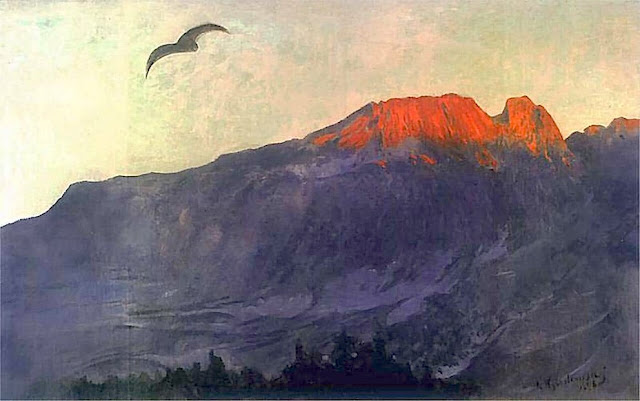MARTIROS SERGEYEVICH SARYAN (1880-1972)
Azhdahak Volcano (3,597 m - 11,801 ft)
Armenia
In Gegham Mountains, oil on canvas, Saryan Museum, Erevan
The volcano
Azhdahak (Աժդահակ) (3,597 m - 11,801 ft) is a volcano in Armenia, the highest point of Gegham mountains. It is part of the Ghegam Ridge volcanic field, which last erupted at 1900 BC ± 1000. There is a lake in the crater of volcano Azhdahak that is formed from melting snow. From the top of the mountain opens the pictorial landscape of mountains Ararat, Hatis, Ara, Aragats, Lake Sevan, the whole Gegham mountains and the Kotayk valley. In the surroundings of Azhdahak there is a lake, Akna of volcanic origin. “Akn” means "spring (water)" in Armenian. A great number of petroglyphs – rock-carvings has been found in the surroundings of Azhdahak. Most images depict men in scenes of hunting and fighting, as well as astronomical bodies and phenomena: the Sun, the Moon, constellations, the stellar sky, lightning, etc.
In Gegham mountains are engaged the cattle breeding people called Yazidi – one of national minorities of Armenia, who move to the mountains for the summer and live in tents with families and even with infants. The Yazidis are an ethno-confessional group, whose main identity is religion; Yazidism or Sharfadin. Nomadic stockbreeding is their major occupation. The Yazidi society is a caste system including three main components: the Shaykhs, the Pirs (clergy) and murids (laymen).
The beauty of the Azhdahak surroundings have long attracted tourists. However, the probability of running across each other different hiking groups is insignificant. It depends on the remoteness from the civilization, orientation complexities, that aggravate with weather condition factors, such as: thunder and lightning, hail and snow, fog with visibility down to 2-3m.
The painter
Martiros Saryan ( Մարտիրոս Սարյան) was the founder of a modern Armenian national school of painting. In 1895, aged 15, he completed the Nakhichevan school and from 1897 to 1904 studied at the Moscow School of Arts, including in the workshops of Valentin Serov and Konstantin Korovin. He was heavily influenced by the work of Paul Gauguin and Henri Matisse. He exhibited his works in various shows. He had works shown at the Blue Rose Exhibit in Moscow.
He first visited Armenia, then part of the Russian Empire, in 190. He composed his first landscapes depicting Armenia (1902-1903- which were highly praised in the Moscow press.
From 1910 to 1913 he traveled extensively in Turkey, Egypt and Iran. In 1915 he went to Echmiadzin to help refugees who had fled from the Armenian genocide in the Ottoman Empire.
In 1916 he traveled to Tiflis (now Tbilisi) where he married Lusik Agayan. It was there that he helped organise the Society of Armenian Artists.
After the Bolshevik seizure of power in 1917 he went with his family to live in Russia. In 1921 they moved to Armenia. While most of his work reflected the Armenian landscape, he also designed the coat of arms for Armenian SSR and designed the curtain for the first Armenian state theatre.
From 1926–1928 he lived and worked in Paris, but most works from this period were destroyed in a fire on board the boat on which he returned to the Soviet Union. From 1928 until his death, Saryan lived in Soviet Armenia.
In the difficult years of the 1930s, he mainly devoted himself again to landscape painting, as well as portraits. He also was chosen as a deputy to the USSR Supreme Soviet and was awarded the Order of Lenin three times and other awards and medals. He was a member of the USSR Art Academy (1974) and Armenian Academy of Sciences (1956).
Saryan died in Yerevan on 5 May 1972. His former home in Yerevan is now a museum dedicated to his work with hundreds of items on display. He was buried in Yerevan at the Pantheon next to Komitas Vardapet.
___________________________________________
2021 - Wandering Vertexes...
by Francis Rousseau









